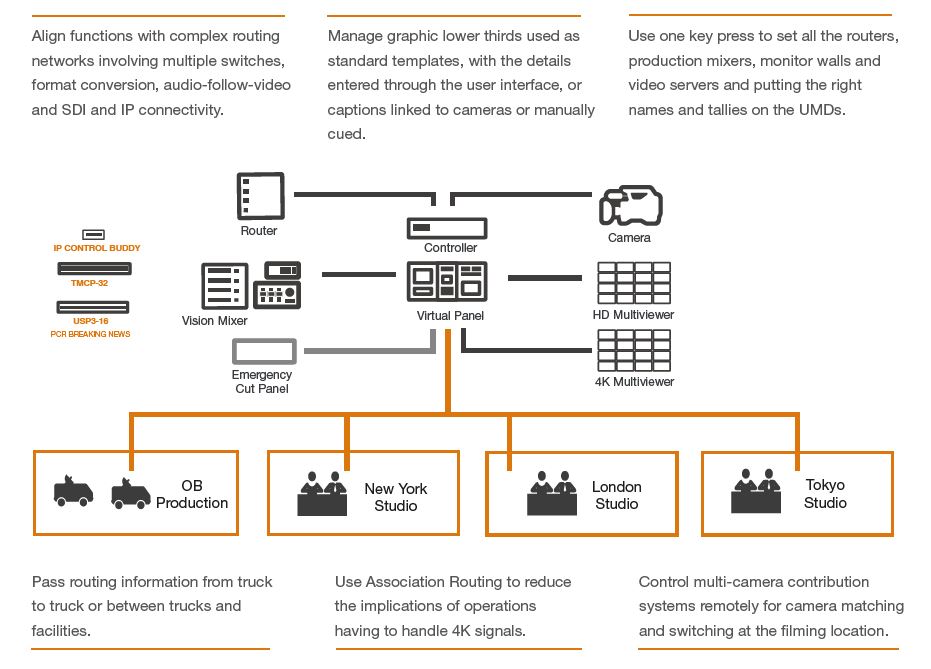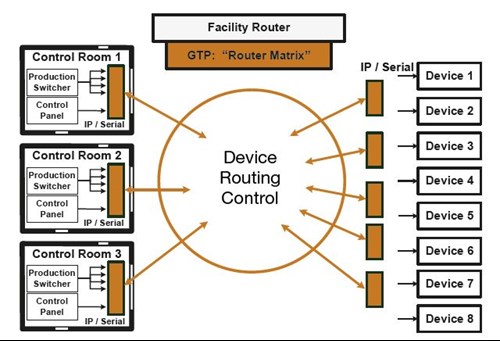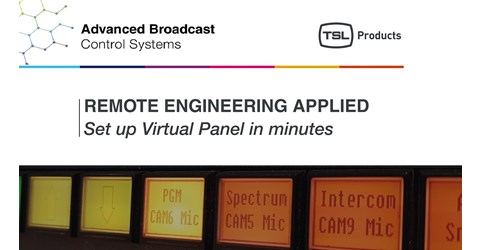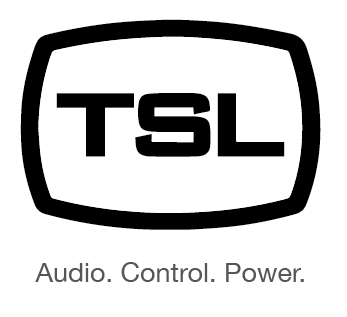EXPLORE THE HUB: Hot Topcis and Deep Dives | Ebooks and Technical Application | Case Studies
Commercial Benefits of Unified Control
Media businesses are seeking to minimise their expenditure, and chief engineers tend to get tasked with achieving more while simultaneously saving money.
Cost savings can be made by using an advanced control system to layer over existing operations:
- Share technology between multiple locations through the unified control layer.
- Reduce staffing levels and minimise reworking through errors by putting the appropriate amount of control under the hands of a single operator.
- Let production values increase while limiting the need for staff to be retrained and to devote time to complex operations.
- Minimise the number of operational control panels needed by managing the functionality across a controlled system via unfied interfaces.

Through using a unified control platform, the technology exists to design complex systems with rich functionality under the control of a single interface. The benefits in ensuring simple, risk-free operation are obvious: you design the control interfaces to do precisely what you need the system to do.
Meanwhile, distributed control can unleash more power by integrating production equipment, workflows, and the multitude of playout platforms using web-based configuration and a wide range of tactile, bridging surfaces to replace an impossible-to-support custom solution, extend the life of your equipment, or integrate sophisticated control with multi-format delivery. The result is highly reliable performance and dramatically simplified upgradability with minimal downtime, you scale and adapt the system as your requirements change.

While the operational advantages are obvious, what is the business case? Are there cost implications? Does this solution deliver financial advantages?
There is much debate in the industry about the move from a capital expenditure basis, built on large, expensive hardware architectures, to an operational expenditure basis, relying rather more on software licences. Competing voices argue in favour of capex and opex, but in truth, media businesses prefer to minimise their expenditure either way, and chief engineers tend to get tasked with achieving more while simultaneously saving money.
A unified control system delivers both capex and opex savings, and sits equally comfortably within a traditional environment, a software-defined architecture, or a hybrid transitional system.
In terms of capex, a control system offers the ability to reduce the amount of hardware you need to buy. Most obviously, you minimise the number of operational control panels you have to purchase and install, as any functionality on any controlled system can be managed via unified interfaces, incorporating new equipment and technological advances to streamline processes and increase efficiencies, minimizing expenses and increasing profitability.
Further, you can potentially reduce the amount of systems you need, where you can share technology between multiple locations. You might have four occasional use remote studios, each fitted with multiple cameras. But you only need one set of camera control equipment – not to mention production switcher and audio mixer – at base, managed through the unified control layer, and switched to the appropriate studio when it is required.
By putting just the appropriate amount of control under the hands of a single operator you inherently reduce staffing levels and minimise reworking through errors. This improves system reliability, supports system expansion, and simplifies system maintenance while minimizing short-term and long-term cost of ownership.
The operational staff also have more time to undertake different tasks, by using tools that are can be easily configured for specific needs, with added peace of mind and security.
Remember that this is just the control layer. It provides simple and intuitive operations, whatever the equipment under control. As the facility moves from traditional broadcast hardware to a software-defined architecture (and possibly from capex to opex) the control layer does not change. Staff do not need to be retrained: the operation still looks the way it always has, and you gain peace of mind that custom boxes, hand-built relay systems, one-off kluged solutions, or custom software is not required.
The commercial case for unified control is strong. It allows production values to rise while limiting the need for staff to be retrained and to devote time to complex operations. It delivers richer solutions, and it makes them easier, and more reliable, to operate.

GAIN CONTROL IN MINUTES WITH VIRTUAL PANEL - DEMO
Virtual panels can replicate full studio controls, camera controls, routing panels, signal flows, pre-sets and source names, all configured by the user with minimal training.
Watch the Demo Here


FLEX CONTROL NETWORK MOVES TO LINUX
This moves adds sustainable benefits and the addition of the virtualised GTP-V1 product, offering greater flexibility and increased rack density for more advanced installations, ease of management and life cycle.
- Lower power consumption and heat generation (46%), we are becoming ever more aware of efficiency savings of both power and cooling, but also the greater effects of energy consumption for a reduced carbon footprint.
- Virtualise GTP works as a virtual machine on existing hardware so can run with most cloud solutions. Having the choice allows the customer to invest where they want / need.


